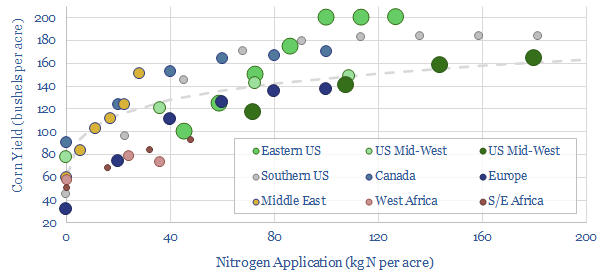How much does fertilizer increase crop yields? To answer this question, we tabulated data from technical papers. Aggregating all of the global data, a good rule of thumb is that up to 200kg of nitrogen can be applied per acre, increasing corn crop yields from 60 bushels per acre (with no fertilizer) to 160 bushels per acre (at 200 kg/acre).
The relationship is almost logarithmic. The first 40 kg/acre of nitrogen application doubles crop yields, from 60 bushels per acre to around 130 kg/bushel. The next 20 kg/acre adds another 5% to crop yields. The next 20kg/acre adds 4%. The next 20kg/acre adds 3%. And so on. Ever greater fertilizer applications have diminishing returns.
In 2022-23, many decision-makers and ESG investors are asking whether energy shortages will translate into fertilizer shortages, which in turn translate into food shortages. The answer depends. A 10kg/acre cut in nitrogen fertilizer may have a negligible 0-2% impact on yields in the most intensive developed world farming. Whereas it may have a disastrous, >10% impact in the developing world, on the “left hand side” of our logarithmic curves.
The scatter is broad, and shows that corn yields are a complex function of climate, weather, crop rotations, soil types, irrigation, other soil nutrients; and the nuances of how/when fertilizers are applied in the growing cycle. Nitrogen that is applied in the form of ammonia, ammonium nitrate, urea or NPK is always prone to denitrification, leaching, volatilization, and being uptaken by non-crop plants.
Moreover, while this data-file evaluates corn, the world’s most important crop by energy output, the relationship may be different for other crops. Corn is particularly demanding of nitrogen in its reproductive stages of growth. This ridiculously prolific crop will have 55% of its entire biomass invested in its ‘ears’ by the time of maturity. These ears contain so much nitrogen than around 70% is sourced by remobilizing nitrogen out of leaves and stems.
How much does fertilizer increase crop yields? For economic reasons. And to minimize the CO2 intensity of crop production. As a rule of thumb, the CO2 intensity of corn crop production is 75kg/boe, of which 50kg/boe is due to nitrogen fertilizer.
A constructive conclusion is that the first c40-80 kg/acre of nitrogen application does not increase CO2 intensity, or may even decrease it due to much greater yields. Best-fit formulae are derived in this data-file, using the data. So are our notes from technical papers, of which our favorite and most helpful was this paper from PennState.
We still see upside in conservation agriculture, and question marks over excessive reliance upon some biofuels as part of the energy transition.
